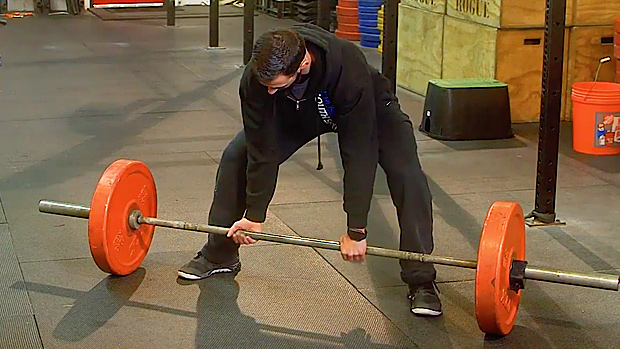Ever meet one of those true strength freaks? One of those guys that can bench 300 for reps, deadlift 500, dunk a basketball, and carry heavy furniture around like it's plastic lawn chairs?
While this kind of full body strength is impressive – not to mention useful when you need someone to help you move – it's also a fine example of exceptional core strength.
Now I've done it. I said "core," which immediately conjures up images of 30-second ab infomercial products and skinny men in spandex contorting on Bosu balls.
However, I prefer to use the word core as how the dictionary defines it: "the basic or most important part; the essence." Extending this definition to training, it means your seemingly strong physique is nowhere near its true potential if your core strength isn't up to par.
Now there's no shortage of good core training articles available, and literally dozens of very effective exercises. But one of the problems with even sound core training advice is a lack of relevance to what you want to improve.
Considering you're reading T Nation, there's a good chance that you want to improve your squat, bench, and deadlift. So what will ground-based core exercises do for you?
Answer is, very little. You might improve your "isolated" core strength, but your performance in the Big 3 will likely be unaffected.
To get truly strong you need to choose what I call full contact core exercises. By "full contact" I don't mean getting hoofed in the bread basket for sets of 8-10, but rather specific exercises that address and eliminate what I refer to as energy leaks.
Here's an example: If your back rounds in the squat and deadlift, that's an energy leak. And because you didn't stabilize the trunk sufficiently, your power will fail to transfer from the ground to the bar. The consequence of this is injury, or a failed and ugly lift. So you need to find core exercises to address this.
The following four steps will help you develop a full contact core in no time. However, under no circumstances may you skip a step.
Imagine when you were a kid if you tried to skip the walking stage and went straight from crawling to sprinting. Exactly. Swallow your pride, do the steps in order, and derive the full benefits.
I'll also provide two different exercise examples and progressions. You can use both or choose the one that best suits your routine.
The first step is all about creating tension. Isometric contractions are an effective way to learn this skill – most are familiar with planks and other foundational shit – but I've found moving resistance over short distances with control is better.
Full Contact Twist – Arm Movement Only
Start by holding a plank position with tense glutes, abs, and thighs. Squeeze the bar and push forward with one arm while pulling the bar with the other to create upper body tension. This helps prevent energy leaks in the shoulders and elbows.
Slowly rotate the arms to one side, pause for a second, and then return to the start position before switching sides. The goal is to be able to hold a position with maximum tension while performing a slow arm movement, all without letting any other body segment move significantly.
Band Rotations – Arm Movement Only
I learned this from Nick Tumminello and it's a great way to teach athletes what a full contact core is all about. Start in what's known as a "pallof press" position with maximum tension in the glutes and abs, and then rotate the hands between the shoulders.
Note: these should be small, rhythmic movements. Avoid using the hips or momentum to create the movement. Try standing in front of a mirror and making sure the navel doesn't move at all. If you can manage that, you're stable.
The second step is all about grinding. An often-used analogy for grinding versus exploding is the comparison of a tow truck and a sports car. If your car gets stuck in a snow bank on a winter night you want a tow truck to come save your bacon, not a Ferrari.
To lift heavy weights, you have to be able to create considerable tension. While it's tempting to attack a big-ass weight with maximum speed, it isn't always effective as the faster you move, the less force is generated.
You can always try moving faster through a sticking point once you start slow, but what happens if you explode into a sticking point and then get stuck?
The key is to learn to grind and control the force with the following grinding moves.
Grinding Full Contact Twist
The full contact twist exercise also includes hip movement. While you worked with a tight trunk in the first exercise, here you're moving your hips while still remaining tight. This teaches you to transfer force as a single unit and while moving, stopping, decelerating, and accelerating.
Start the rotation to one side while pivoting with the feet. Lower the bar close to the thigh and under control before moving it with tension back up. Make sure to start the movement with the hips. The movement is very similar to what happens while punching and throwing.
Grinding Band Hip Rotations
This exercise is very similar to the full contact twist. From the same starting position as the previous exercise, rotate toward the attachment point with the hips while remembering to stay tight and not leak energy from the trunk.
Next, rotate in the other direction with the same hip action as with the full contact twist.
After you've learned how to generate maximum tension and grind, it's time to explode!
This step closely resembles the often advocated "controlled eccentric and explosive concentric" lifting mantra. This is an effective lifting cadence for both hypertrophy and maximum strength development but you still need to know how to stay tight! And this is how to do it.
Full Contact Twist – Slow to Fast
This exercise is performed like the previous version in step #2, but now you slowly lower the bar and pause for a full second before exploding up. Make sure you create max tension before exploding. If you can't, start lighter.
Controlled Band Rotations – Slow to Fast
This is also performed like its previous version in step #2, but again you add the pause for a second before exploding up.
Reactive training methods are very important training tools, especially for athletes that have to be able to react when heavy objects (such as a 230-pound fullback) are rushing their way.
To effectively decelerate an object with high velocity you have to get extremely tight, fast – you essentially have to create an immediate pulse of maximum tension as there's no time to slowly build it up. In this fourth and final step you'll work to develop this vital quality.
As stated before, you can't skip steps. Jump in here at number 4 and you'll only get injured. You've been warned.
Explosive Twists
While the basic movement is similar to what you've already done, here you have to "jump" from position to position. This creates less control as each repetition will vary somewhat from the previous one. Because of this you must be able to demonstrate a full contact core despite slight deviations from a pre-planned path.
Explosive Band Rotations
Again, the execution is similar, only with a faster eccentric phase. Even though it's easier and less dangerous than the explosive twist exercise above, you'll certainly have to work hard to prevent energy leaks.
Now it's up to you. Are you willing to let sub-optimal core training sabotage your strength and hypertrophy gains? Or are you going to embrace the power of intelligent core training?
It should be an easy decision. By learning to develop total control over a given resistance, you harness the power of energy transfer, thereby maximizing your strength potential.
All by developing a full contact core!




